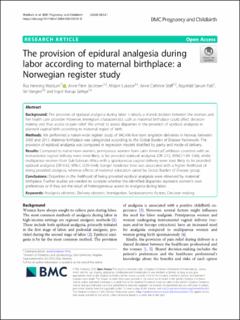| dc.contributor.author | Waldum, Åsa | |
| dc.contributor.author | Jacobsen, Anne Flem | |
| dc.contributor.author | Lukasse, Mirjam | |
| dc.contributor.author | Staff, Anne Cathrine | |
| dc.contributor.author | Falk, Ragnhild Sørum | |
| dc.contributor.author | Vangen, Siri | |
| dc.contributor.author | Sørbye, Ingvil | |
| dc.date.accessioned | 2021-03-05T12:15:40Z | |
| dc.date.available | 2021-03-05T12:15:40Z | |
| dc.date.created | 2021-01-19T08:52:54Z | |
| dc.date.issued | 2020 | |
| dc.identifier.citation | Waldum, Å. H., Jacobsen, A. F., Lukasse, M., Staff, A. C., Falk, R. S., Vangen, S. & Sørbye, I. K. (2020). The provision of epidural analgesia during labor according to maternal birthplace: a Norwegian register study. BMC Pregnancy and Childbirth, 20, 321. | en_US |
| dc.identifier.issn | 1471-2393 | |
| dc.identifier.uri | https://hdl.handle.net/11250/2731863 | |
| dc.description.abstract | Background: The provision of epidural analgesia during labor is ideally a shared decision between the woman and her health care provider. However, immigrant characteristics such as maternal birthplace could affect decisionmaking and thus access to pain relief. We aimed to assess disparities in the provision of epidural analgesia in planned vaginal birth according to maternal region of birth.
Methods: We performed a nation-wide register study of 842,496 live-born singleton deliveries in Norway between 2000 and 2015. Maternal birthplace was categorized according to the Global Burden of Disease framework. The provision of epidural analgesia was compared in regression models stratified by parity and mode of delivery.
Results: Compared to native-born women, primiparous women from Latin America/Caribbean countries with an instrumental vaginal delivery were most likely to be provided epidural analgesia (OR 2.12, 95%CI 1.69–2.66), whilst multiparous women from Sub-Saharan Africa with a spontaneous vaginal delivery were least likely to be provided epidural analgesia (OR 0.42, 95% C 0.39–0.44). Longer residence time was associated with a higher likelihood of being provided analgesia, whereas effects of maternal education varied by Global Burden of Disease group.
Conclusions: Disparities in the likelihood of being provided epidural analgesia were observed by maternal birthplace. Further studies are needed to consider whether the identified disparities represent women’s own preferences or if they are the result of heterogeneous access to analgesia during labor. | en_US |
| dc.language.iso | eng | en_US |
| dc.rights | Navngivelse 4.0 Internasjonal | * |
| dc.rights.uri | http://creativecommons.org/licenses/by/4.0/deed.no | * |
| dc.title | The provision of epidural analgesia during labor according to maternal birthplace: a Norwegian register study | en_US |
| dc.type | Peer reviewed | en_US |
| dc.type | Journal article | en_US |
| dc.description.version | publishedVersion | en_US |
| dc.rights.holder | © The Author(s), 2020. | en_US |
| dc.source.volume | 20 | en_US |
| dc.source.journal | BMC Pregnancy and Childbirth | en_US |
| dc.identifier.doi | https://doi.org/10.1186/s12884-020-03021-8 | |
| dc.identifier.cristin | 1873885 | |
| dc.source.articlenumber | 321 | en_US |
| cristin.ispublished | true | |
| cristin.fulltext | original | |
| cristin.qualitycode | 1 | |

